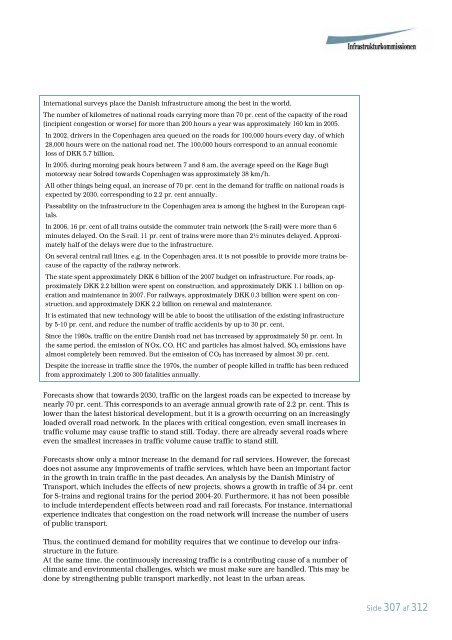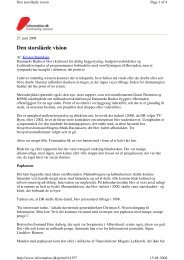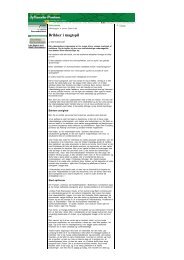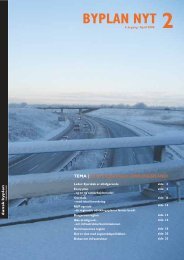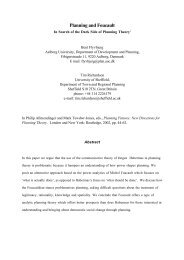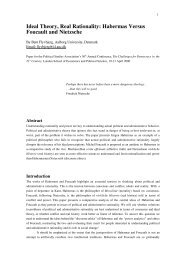Danmarks Transportinfrastruktur 2030 - Bent Flyvbjerg - Aalborg ...
Danmarks Transportinfrastruktur 2030 - Bent Flyvbjerg - Aalborg ...
Danmarks Transportinfrastruktur 2030 - Bent Flyvbjerg - Aalborg ...
You also want an ePaper? Increase the reach of your titles
YUMPU automatically turns print PDFs into web optimized ePapers that Google loves.
International surveys place the Danish infrastructure among the best in the world.<br />
The number of kilometres of national roads carrying more than 70 pr. cent of the capacity of the road<br />
(incipient congestion or worse) for more than 200 hours a year was approximately 160 km in 2005.<br />
In 2002, drivers in the Copenhagen area queued on the roads for 100,000 hours every day, of which<br />
28,000 hours were on the national road net. The 100,000 hours correspond to an annual economic<br />
loss of DKK 5.7 billion.<br />
In 2005, during morning peak hours between 7 and 8 am, the average speed on the Køge Bugt<br />
motorway near Solrød towards Copenhagen was approximately 38 km/h.<br />
All other things being equal, an increase of 70 pr. cent in the demand for traffic on national roads is<br />
expected by <strong>2030</strong>, corresponding to 2.2 pr. cent annually.<br />
Passability on the infrastructure in the Copenhagen area is among the highest in the European capitals.<br />
In 2006, 16 pr. cent of all trains outside the commuter train network (the S-rail) were more than 6<br />
minutes delayed. On the S-rail, 11 pr. cent of trains were more than 2 minutes delayed. Approximately<br />
half of the delays were due to the infrastructure.<br />
On several central rail lines, e.g. in the Copenhagen area, it is not possible to provide more trains because<br />
of the capacity of the railway network.<br />
The state spent approximately DKK 6 billion of the 2007 budget on infrastructure. For roads, approximately<br />
DKK 2.2 billion were spent on construction, and approximately DKK 1.1 billion on operation<br />
and maintenance in 2007. For railways, approximately DKK 0.3 billion were spent on construction,<br />
and approximately DKK 2.2 billion on renewal and maintenance.<br />
It is estimated that new technology will be able to boost the utilisation of the existing infrastructure<br />
by 5-10 pr. cent, and reduce the number of traffic accidents by up to 30 pr. cent.<br />
Since the 1980s, traffic on the entire Danish road net has increased by approximately 50 pr. cent. In<br />
the same period, the emission of NOx, CO, HC and particles has almost halved. SO2 emissions have<br />
almost completely been removed. But the emission of CO2 has increased by almost 30 pr. cent.<br />
Despite the increase in traffic since the 1970s, the number of people killed in traffic has been reduced<br />
from approximately 1,200 to 300 fatalities annually.<br />
Forecasts show that towards <strong>2030</strong>, traffic on the largest roads can be expected to increase by<br />
nearly 70 pr. cent. This corresponds to an average annual growth rate of 2.2 pr. cent. This is<br />
lower than the latest historical development, but it is a growth occurring on an increasingly<br />
loaded overall road network. In the places with critical congestion, even small increases in<br />
traffic volume may cause traffic to stand still. Today, there are already several roads where<br />
even the smallest increases in traffic volume cause traffic to stand still.<br />
Forecasts show only a minor increase in the demand for rail services. However, the forecast<br />
does not assume any improvements of traffic services, which have been an important factor<br />
in the growth in train traffic in the past decades. An analysis by the Danish Ministry of<br />
Transport, which includes the effects of new projects, shows a growth in traffic of 34 pr. cent<br />
for S-trains and regional trains for the period 2004-20. Furthermore, it has not been possible<br />
to include interdependent effects between road and rail forecasts. For instance, international<br />
experience indicates that congestion on the road network will increase the number of users<br />
of public transport.<br />
Thus, the continued demand for mobility requires that we continue to develop our infrastructure<br />
in the future.<br />
At the same time, the continuously increasing traffic is a contributing cause of a number of<br />
climate and environmental challenges, which we must make sure are handled. This may be<br />
done by strengthening public transport markedly, not least in the urban areas.<br />
Side 307 af 312


